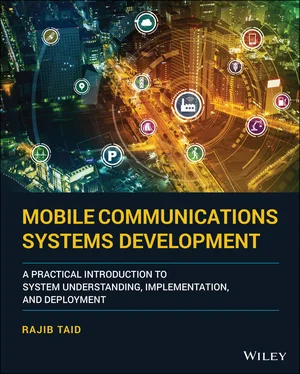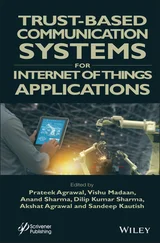Conditional (C) – Presence depends on the value of another IE. If a condition is met and the IE is not present, the receiver will consider the message as an erroneous one; else, it will accept the message.
Optional (O) – The receiver will accept the received message irrespective of the presence of the IE.
IE Formats
As shown in Figure 4.1, each IE of a signaling message has the type (T), represented by the IEI, along with a defined range of values (V), including reserved value, and its length (L). The type (T), length (L), and allowed value (V) of IEs of signaling messages of a particular protocol layer are defined by its corresponding 3rd Generation Partnership Project (3GPP) technical specification. Using the Type, Length and Value (TLV), several formats of an IE can be defined as shown in Figure 4.3; refer to TS 24.007 [44]. The formats “LV‐E” and “TLV‐E” indicate that these IE formats are used in the case of the LTE/EPS system only for its air interface Layer 3 MM and SM messages. GSM, GPRS, UMTS, LTE, and 5G NR air interface messages defined and encoded in TLV formats are called Standard Messages .
IE Types

Figure 4.2 Presence requirements of an IE of a protocol message.

Figure 4.3 Standard formats of air interface layer 3 messages IEs.
Source: © 2011. 3GPP ™ TSs and TRs are the property of ARIB, ATIS, CCSA, ETSI, TSDSI, TTA and TTC who jointly own the copyright in them. © 2011, 3GPP.
The IEs of the GSM, GPRS Layer 3 and UMTS, LTE, and 5G NR NAS layer signaling messages are octet aligned. Depending on the usage of the IEI, length (L) of an IEI, and its value (V), the IE can be represented in one of the formats as shown in Figure 4.3. The particular format used to encode an IE represents its corresponding type . The different types of IE are mentioned below:
Type 1: IE format – V (with a half octet in length) and TV (each is half octet in length),
Type 2: IE format – T, i.e. IEI only (1 octet in length),
Type 3: IE format – TV (length of IEI is 1 octet; length of value: 1..n octet),
Type 4: IE format – LV, TLV (length of IEI is 1 octet, length of value: 1..n octet, and length of length indicator: 1 octet), and
Type 6: IE format – LV‐E, TLV‐E (length of IEI is one octet, length of value: 1..n octet, and length of length indicator: 2 octets).
For more information on the above IE, its format, and types, refer to the 3GPP TS 24.007 [44].
Encoding/Decoding of IEsThe IEs of a signaling message is encoded by the sender and decoded by the receiver in order of their appearances in the tabular description. IEs are encoded as octet aligned.Only the IEI/Type (T), Length (L), and Value (V) of an IE are encoded/decoded as per their tabular descriptions of the concerned message. Because of the TLV encoding, the overall message size becomes larger for transmission over the air interface.
In case an IE in a message is encoded incorrectly, a protocol error is detected and flagged by the receiver of the message which is notified to the sending network element about the detected error so that the predefined actions may be taken. For example, if an MS/UE sent an IE to the CN that is not encoded correctly, the CN element will report an error to the RAN. Further, the RAN may report about the error to the operation and maintenance personal through a predefined alarm.
Usages of IEs, their formats/lengths, i.e. TLV, and presence requirements in a NAS signaling message are illustrated through Example s 4.1to 4.3.
From the LTE/EPS Attach Complete message definition which is shown in Figure 4.4, the following observations may be made:
Tabular Description of Air Interface NAS Layer Signaling Message
All the air interface Layer 3 and NAS layer messages and their IEs are described in a tabular format with six columns. IEIs are arranged in the order they are transmitted.
For an IE having its format type (T), the corresponding IEI is mentioned in the first column, IEI, of the table.
Figure 4.4contains IEs with format types: V and LV.
Note that the GSM, GPRS, UMTS, air interface Layer 3, and LTE and 5G NAS layer signaling messages have protocol header part followed by IEs for user information /data part that is defined in a tabular format as shown in Figure 4.4. It may be noted that though the message description in tabular format is the same, the protocol headers used across the different air interfaces are different.
Example 4.1Illustration of LTE/EPS NAS MM Layer Message
Consider the LTE/EPS Attach Complete NAS layer EMM message (see Figure 4.4) reproduced from TS 24.301 [46], which is sent from the UE to the Mobility Management Entity (MME) through the eNodeB. They are described in the tabular format and also their encoding method, i.e. IE format‐TLV, is the same. But there is a difference between the GSM, UMTS, GPRS and LTE/EPS, and 5G NAS layer messages. The GSM, GPRS, and UMTS air interface Mobility Management (GMM) messages are not security protected, but every LTE/EPS, 5GS NAS, MM layer message is security protected. For this purpose, the header of every LTE/EPS EMM or 5G MM message contains the Security Header Type IE.

Figure 4.4 LTE/EPS NAS layer 3 attach complete message.
Source: © 2014. 3GPP ™ TSs and TRs are the property of ARIB, ATIS, CCSA, ETSI, TSDSI, TTA and TTC who jointly own the copyright in them. © 2014, 3GPP.
Example 4.2 Illustration of LTE/EPS NAS SM Layer Message
Consider the LTE/EPS ESM Information Request NAS message (see Figure 4.5) which is sent from the MME to the UE through the eNodeB. It is described in a tabular format and their encoding method, i.e. IE format, is the same. Unlike the GSM/GPRS Layer 3 SM messages, the protocol header of every LTE/EPS NAS layer message contains an EPS Bearer Identity and a Procedure Transaction Identity; refer to TS 24.301 [46]. In the case of the 5G system NAS layer, a 5GSM message contains a PDU Session ID and a Procedure Transaction Identity .

Figure 4.5 LTE/EPS NAS layer 3 ESM information request message.
Source: © 2014. 3GPP ™ TSs and TRs are the property of ARIB, ATIS, CCSA, ETSI, TSDSI, TTA and TTC who jointly own the copyright in them. © 2014, 3GPP.
Example 4.3Illustration of Encoding and Transmissions of Layer 3/NAS Layer Message
LTE/EPS air interface NAS layer messages and their tabular definitions/descriptions have been presented in the previous examples. It has been observed that the types, in TLV format, of the different IEs of a particular message are not the same, but they are mixed in nature, i.e. Type 1, Type 2, and so on. Figure 4.6illustrates one such typical encoding of IEs of a Layer 3 messages header (1 octet, value only); message type (1 octet, value only); and followed by a typical IE in TLV format for transferring between an MS and the RAN over the respective air interface. The IEs of a message are encoded at the sender and decoded at the receiver in the same order as it is defined in its concerned technical specification.
Читать дальше
















